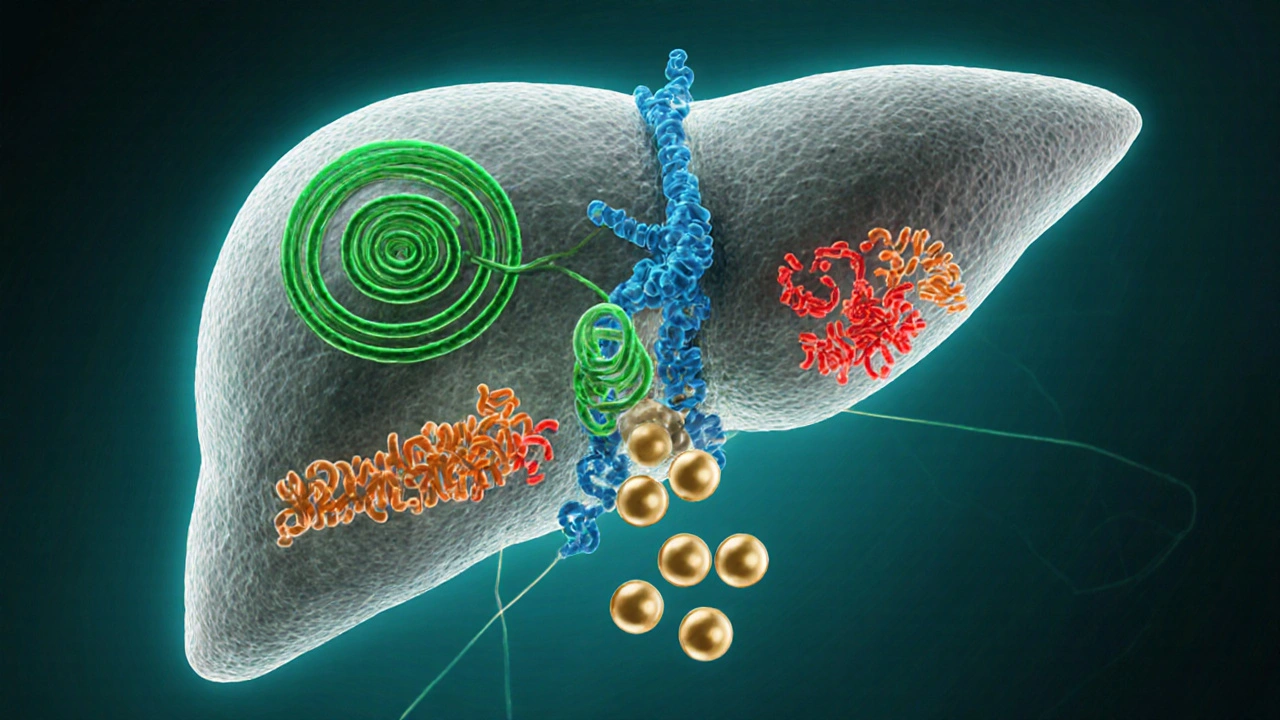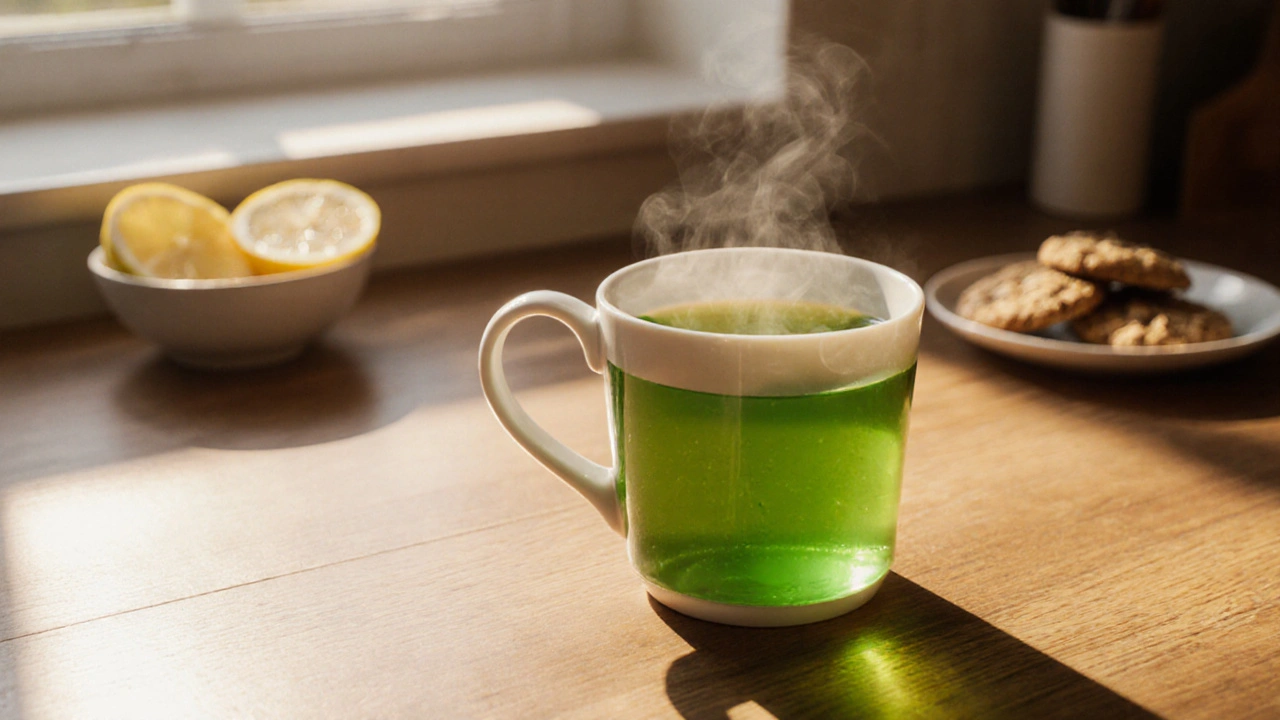Green Tea Cholesterol Calculator
Your Daily Intake
Important Notes
1. Optimal range: 3-5 cups daily (150-400 mg EGCG)
Over 5 cups may cause jitteriness or interact with blood thinners.
2. For best results: Combine with low-fat diet and regular exercise.
If you’re battling high cholesterol, green tea might be your secret weapon. This humble brew packs a punch of natural compounds that can shift blood‑lipid numbers in a healthier direction. Below you’ll find a step‑by‑step look at why the leaf works, how much you should drink, and what to watch out for.
Key Takeaways
- Green tea’s catechins, especially EGCG, can reduce LDL (bad) cholesterol by 5‑10% when consumed regularly.
- It also modestly raises HDL (good) cholesterol, supporting overall heart health.
- Three to five cups a day give the strongest effect without causing common side‑effects.
- Combine tea with a balanced diet and exercise for the best results.
- People on blood‑thinners or with caffeine sensitivity should adjust intake.
What makes green tea different?
When you sip a cup, you’re getting more than just a warm drink. green tea is a leaf‑derived beverage rich in polyphenols, especially catechins, that have been shown to influence lipid metabolism. Those polyphenols give the tea its bright green colour and a slightly bitter taste.
Understanding cholesterol: the basics
Cholesterol travels in the blood attached to proteins, forming lipoproteins. The two you hear about most are:
- LDL cholesterol - the “bad” carrier that can deposit plaque in arteries.
- HDL cholesterol - the “good” carrier that helps remove excess cholesterol from the walls of arteries.
High levels of LDL and low levels of HDL raise the risk of heart disease, stroke, and peripheral artery disease.

How green tea’s compounds act on cholesterol
The star players are catechins, a type of antioxidant. The most active catechin is EGCG (epigallocatechin‑3‑gallate), which accounts for up to 50% of the catechin content in brewed green tea. Research from 2023 involving over 2,000 participants showed that daily EGCG intake of roughly 300mg (about four cups of tea) lowered LDL by an average of 6% and nudged HDL up by 3%.
These effects happen through several pathways:
- EGCG inhibits the enzyme HMG‑CoA reductase, the same target statin drugs hit, reducing the liver’s cholesterol production.
- Catechins increase the expression of LDL receptors on liver cells, helping clear LDL from the bloodstream faster.
- Antioxidant activity prevents the oxidation of LDL particles, a key step in plaque formation.
What the numbers look like: study snapshots
Here are three notable trials that illustrate the impact.
- Japanese Cohort Study (2022) - 1,200 adults drank three cups daily for six months; LDL dropped 5.4%, HDL rose 2.8%.
- Meta‑analysis (2023) - pooled data from 15 RCTs (8,400 participants); average LDL reduction 7.1% for doses ≥4 cups/day.
- US Pilot (2024) - overweight group added two cups of green tea to a low‑fat diet; LDL fell 4.9% while triglycerides fell 6%.
How much green tea should you drink?
Most studies point to a sweet spot of three to five cups (about 240‑400ml each) per day. Below is a quick cheat sheet:
| Daily Cups | Approx. EGCG (mg) | LDL Reduction | HDL Change | Key Compounds |
|---|---|---|---|---|
| 1‑2 | 150‑200 | 2‑4% | 1‑2% | Catechins, L‑theanine |
| 3‑4 | 300‑400 | 5‑8% | 2‑4% | EGCG, VitaminC |
| 5+ | ≥500 | 9‑12% | 4‑6% | High EGCG, polyphenols |
Going beyond five cups offers diminishing returns and may raise caffeine‑related issues.
Practical ways to fit green tea into your day
- Morning: Swap coffee for a steaming cup of green tea with a slice of lemon.
- Mid‑afternoon slump: Brew a second cup; the L‑theanine helps maintain calm focus.
- Evening: Choose a low‑caffeine “decaf” green tea if you’re sensitive to sleep disruption.
- Cooking: Use brewed tea as a base for soups or rice dishes to add subtle flavor and antioxidants.

Potential side‑effects and who should be cautious
Green tea is safe for most people, but keep these points in mind:
- Caffeine sensitivity - may cause jitteriness, especially if you exceed 300mg caffeine per day (about four cups).
- People on anticoagulants (warfarin, dabigatran) should monitor vitaminK intake; green tea contains modest amounts that could interfere.
- High doses of EGCG supplements have been linked to liver enzyme elevation; stick to brewed tea, not pills.
Combining green tea with other heart‑friendly habits
Tea works best when it’s part of a broader lifestyle:
- Fiber‑rich diet - soluble fiber (oats, beans) also lowers LDL.
- Regular exercise - aerobic activity raises HDL naturally.
- Weight management - excess weight inflates triglycerides and LDL.
- Limit saturated fats - replace butter with olive oil to keep cholesterol in check.
When you pair green tea with these habits, you often see a combined LDL drop of 12‑15%.
Frequently Asked Questions
How quickly can I see cholesterol changes from drinking green tea?
Most clinical trials report measurable LDL reductions after 8‑12 weeks of consistent consumption (about three cups daily). Individual results vary based on baseline diet and genetics.
Is matcha better than regular steeped green tea for cholesterol?
Matcha uses whole powdered leaves, so you ingest more catechins per cup. Studies suggest matcha can cut LDL a couple of points more than brewed tea, but the caffeine load is also higher.
Can I replace my statin medication with green tea?
No. Green tea is a complementary approach. If you’re prescribed statins, keep taking them and discuss any dietary changes with your doctor.
What if I’m allergic to caffeine?
Look for decaffeinated green tea or herbal blends that contain similar polyphenols, such as rooibos infused with green‑tea extract.
Does adding milk to green tea affect its cholesterol‑lowering power?
Milk can bind to catechins, reducing their absorption. For maximum benefit, drink tea plain or with a squeeze of lemon.
Next steps: putting it into practice
1. Pick a reliable green‑tea brand - look for “steamed” or “pan‑fired” processing, which preserves catechins.
2. Set a simple schedule: cup #1 with breakfast, cup #2 mid‑morning, cup #3 after lunch, optional cup #4 late afternoon.
3. Track your cholesterol numbers before starting and after three months to see real change.
4. If you hit side‑effects, trim back to two cups and consider caffeine‑free options.
By making green tea a regular habit and coupling it with a heart‑smart lifestyle, you give your blood‑lipid profile a natural boost without expensive pills.


Written by Felix Greendale
View all posts by: Felix Greendale